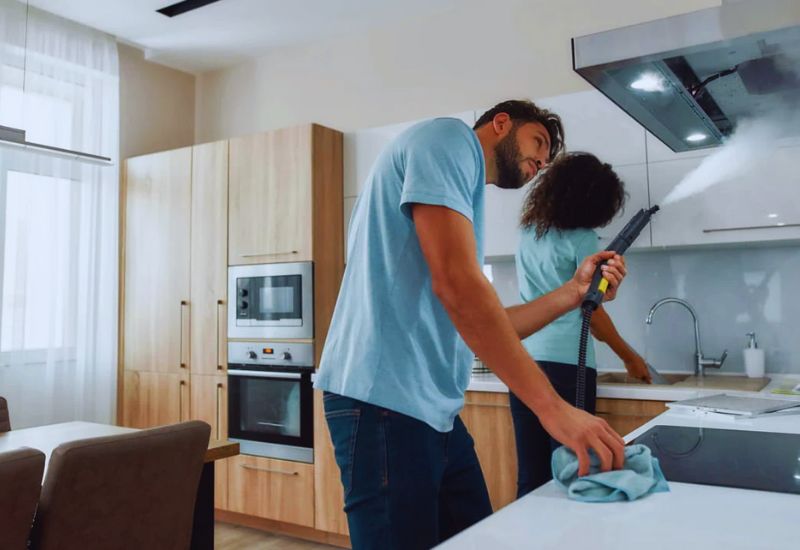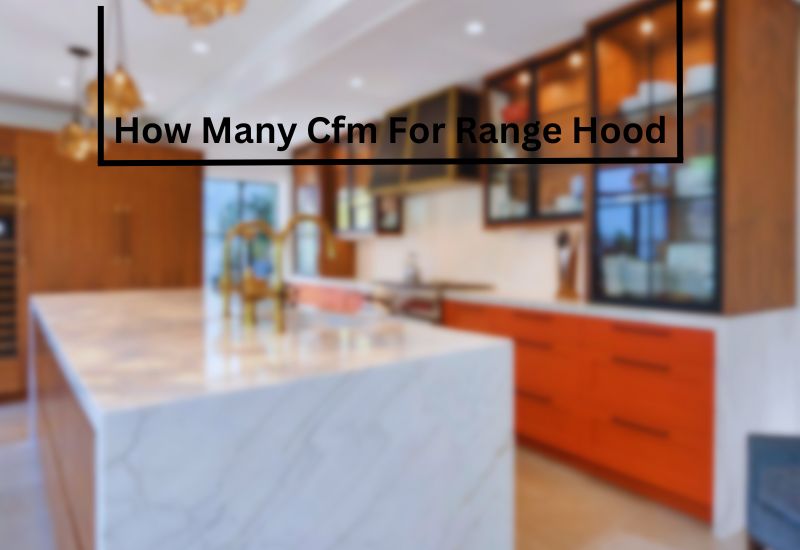Are you planning to upgrade your kitchen or replace your range hood? You might be wondering how many CFM (Cubic Feet per Minute) your range hood should have. CFM is a crucial factor in determining the effectiveness of your range hood in removing cooking odors, smoke, and grease from your kitchen. In simple terms, CFM measures the amount of air the hood can move in one minute.
How Many Cfm For Range Hood? The recommended CFM (cubic feet per minute) for a range hood depends on the size and type of your stove. For most standard residential stoves, a range hood with a CFM rating between 150 to 300 is sufficient. However, for larger or high-output stoves, you may need a higher CFM rating, up to 600 or more, to effectively remove cooking odors and smoke. It’s essential to match the CFM of your range hood to your specific cooking needs for optimal performance.
Choosing the right CFM for your range hood depends on various factors, including the size of your kitchen, the type of cooking you do, and the layout of your home. It’s essential to strike the right balance to ensure your range hood effectively captures and vents out the unwanted kitchen air, making your cooking experience more pleasant and your kitchen environment healthier. In this guide, we’ll walk you through the considerations to help you determine how many CFM your range hood should have for your specific needs.
“Calculating the Perfect CFM for Your Kitchen Range Hood”

In the quest for an efficiently ventilated kitchen, selecting the right CFM (Cubic Feet per Minute) for your range hood is pivotal. This decision hinges on various factors that should be considered thoughtfully.
Understanding Your Cooking Habits
Before diving into CFM calculations, it’s essential to evaluate your cooking habits. Ask yourself how often you cook, the types of dishes you prepare, and whether you tend to cook with strong odors and high heat. This self-awareness will serve as a foundation for determining the adequate CFM for your kitchen.
Sizing Your Kitchen
The size of your kitchen plays a pivotal role in CFM selection. Smaller kitchens typically require lower CFM, while larger spaces demand more robust ventilation. Measure the length, width, and height of your kitchen to get a clear picture of its volume.
BTU Rating of Your Stove
The BTU (British Thermal Unit) rating of your stove or cooktop is another critical factor. Higher BTU ratings imply more heat production, which necessitates a greater CFM to effectively remove smoke, steam, and odors. Be sure to check your appliance’s manual or label for this information.
Ductwork Efficiency
Consider the efficiency of your ductwork. If your kitchen hood is connected to a duct system, ensure it’s in good condition and adequately sized. Inefficient ducts can hinder airflow, making it necessary to compensate with a higher CFM.
Noise Levels
While a powerful range hood can effectively remove pollutants, it may also generate more noise. If noise is a concern, opt for a quieter model or consider adding sound-dampening features to your duct system.
Consult a Professional
In cases where the calculations seem complex or the variables overwhelming, it’s wise to consult a professional. An experienced HVAC technician or kitchen designer can help you assess your needs accurately and recommend the ideal CFM for your kitchen range hood.
“Unveiling the Science of CFM: What You Need to Know for Range Hoods”

In the world of kitchen appliances, range hoods play a vital role in maintaining a clean and pleasant cooking environment. But have you ever wondered about the science behind these kitchen companions? In this informative note, we’ll delve into the science of CFM (Cubic Feet per Minute) and explore what you need to know about range hoods.
Understanding CFM: The Heart of Your Range Hood
At the core of every range hood is the CFM rating, which stands for Cubic Feet per Minute. This measurement quantifies the amount of air a range hood can move in one minute. It’s a crucial factor in determining how effectively a range hood can remove cooking odors, smoke, and grease from your kitchen. The higher the CFM, the more air it can pull and filter, resulting in better ventilation.
Matching CFM to Your Cooking Style
Selecting the right CFM rating for your range hood depends on your cooking habits. If you’re a light cook who rarely uses high-heat cooking methods, a lower CFM may suffice. However, if you frequently indulge in heavy frying or grilling, a higher CFM is essential to handle the increased smoke and grease production.
Ducted vs. Ductless: CFM Implications
Range hoods can be either ducted or ductless. Ducted hoods vent air outside, while ductless ones recirculate it through filters. The CFM requirement differs for each type. Ducted hoods need a higher CFM to efficiently expel air outdoors, while ductless hoods can work with lower CFM ratings since they primarily filter and recirculate the air.
Consider Kitchen Size and Layout
The size and layout of your kitchen play a significant role in CFM selection. A larger kitchen with an open floor plan will require a higher CFM to ensure proper air circulation. On the other hand, a smaller kitchen may be adequately served by a range hood with a lower CFM rating.
Noise Levels: The Trade-Off with Higher CFM
While a higher CFM rating can provide superior ventilation, it often comes with increased noise levels. This is something to consider, especially if your kitchen is open to other living spaces. Look for range hoods with noise-reduction features or opt for a hood with variable speed settings to balance performance and noise.
Maintenance Matters: Filters and CFM
Proper maintenance of your range hood is crucial for maintaining its CFM efficiency. Regularly clean or replace the filters, as dirty filters can reduce CFM and hinder ventilation. Keeping the hood and ducts clean is equally important to ensure optimal performance.
“Sizing Up Your Culinary Space: Choosing the Right CFM for Your Range Hood”

When it comes to setting up your kitchen for culinary adventures, selecting the right range hood is often overlooked but crucial. Your range hood’s CFM (Cubic Feet per Minute) rating plays a significant role in maintaining a clean, odor-free, and comfortable cooking environment. Let’s dive into the essential considerations for choosing the right CFM for your range hood.
Understanding CFM
CFM stands for Cubic Feet per Minute, a measurement of how much air the range hood can move in one minute. It determines the range hood’s ability to remove smoke, heat, odors, and grease generated during cooking.
Matching CFM to Stove Size
The first step in choosing the right CFM is to consider your stove’s size and cooking style. For smaller cooktops or light cooking, a lower CFM (100-400) may suffice. Larger stoves and heavy-duty cooking, such as deep frying, require a higher CFM (600-1200) to effectively remove smoke and odors.
Kitchen Size Matters
The size of your kitchen also plays a role in CFM selection. For compact kitchens, a range hood with a lower CFM can effectively maintain air quality. Larger kitchens, on the other hand, benefit from higher CFM ratings to ensure efficient ventilation throughout the space.
Ducted vs. Ductless Range Hoods
Consider whether your range hood will be ducted or ductless. Ducted hoods vent air outside, while ductless hoods recirculate it through filters. Ducted hoods are more effective at removing contaminants, so if possible, opt for one with a higher CFM.
Noise Levels
The CFM rating can impact the noise levels of your range hood. Higher CFM models tend to be noisier. If a quiet cooking space is essential, look for hoods with noise-reduction features or choose a model with an appropriate CFM for your needs.
Additional Features
Modern range hoods come with various features like multiple fan speeds, timers, and energy-efficient options. Consider these features in addition to CFM when making your selection, as they can enhance your overall cooking experience.
“CFM Selection Demystified: A Step-by-Step Guide to Range Hood Ventilation”

When it comes to kitchen ventilation, choosing the right CFM (Cubic Feet per Minute) for your range hood can be a perplexing task. Understanding the fundamentals is crucial to ensuring a healthy and smoke-free kitchen environment. In this guide, we break down the CFM selection process into easy-to-follow steps, making it accessible to everyone.
Know Your Kitchen Size and Layout:
Before diving into CFM calculations, take stock of your kitchen. Consider its size, layout, and the type of cooking you do. Larger kitchens or those with an open floor plan will require higher CFM ratings to effectively remove cooking odors and grease.
Determine Your Stove’s BTU Rating:
The heat output of your stove, measured in British Thermal Units (BTUs), directly impacts the CFM needed for your range hood. The higher the BTU rating, the more powerful the hood should be to handle the increased cooking heat.
Consider Ducted vs. Ductless Ventilation:
Decide whether you’ll have ducted or ductless ventilation. Ducted systems expel air outside, while ductless ones filter and recirculate it. Ducted hoods are generally more efficient but require proper ductwork installation.
Calculate CFM Requirements:
To determine the CFM you need, calculate the volume of your kitchen by multiplying its length, width, and height. For electric stoves, aim for 100 CFM per linear foot, while gas stoves may require 150 CFM per linear foot. Adjust these values based on your cooking habits and stove BTU rating.
Factor in Extra Features:
If your range hood has extra features like built-in lighting or noise reduction technology, adjust your CFM requirements accordingly. Additional features may impact the effectiveness of the ventilation system.
Consult with a Professional:
When in doubt, seek advice from a professional. A certified kitchen designer or HVAC technician can provide valuable insights and help you choose the right CFM for your specific needs.
Test and Adjust:
After installation, test your range hood to ensure it effectively removes cooking odors and maintains a comfortable kitchen atmosphere. If necessary, adjust the CFM settings to achieve optimal performance.
“Cooking Up Comfort: How CFM Impacts Air Quality in Your Kitchen”

In today’s note, we will dive into a crucial aspect of your kitchen that often goes unnoticed but plays a significant role in ensuring a comfortable and healthy cooking environment: CFM, or Cubic Feet per Minute. Let’s explore how CFM can influence the air quality in your kitchen, making your cooking experience safer and more enjoyable.
Understanding CFM
CFM is a measure of how much air a kitchen exhaust fan can move in a minute. It’s like the fan’s lung capacity – the higher the CFM, the more air it can remove from your kitchen. This air movement is essential for removing cooking odors, excess heat, and harmful particles that can linger when you prepare meals.
Controlling Cooking Odors
When you cook, the delightful aroma of your favorite dishes fills the air. However, if your kitchen doesn’t have adequate CFM, these odors can become overpowering and stick around long after the meal is done. A high CFM exhaust fan helps by quickly whisking away these odors, making your kitchen smell fresh again in no time.
Banishing Excess Heat
Cooking generates heat, and without proper ventilation, your kitchen can become uncomfortably warm. CFM comes to the rescue here as well. A kitchen exhaust fan with a higher CFM rating can efficiently remove heat, keeping your kitchen cool and comfortable while you whip up your culinary creations.
Removing Harmful Particles
Cooking isn’t just about delicious food; it also produces airborne particles like grease and smoke. These particles can be harmful if they accumulate in your kitchen. A robust exhaust fan with a high CFM rating helps trap and eliminate these particles, maintaining better indoor air quality.
Enhancing Safety
Adequate CFM isn’t just about comfort; it’s also about safety. When you cook, especially with gas stoves, there’s a risk of carbon monoxide buildup. A powerful exhaust fan with the right CFM rating ensures that harmful gases are promptly vented outside, reducing the risk of carbon monoxide poisoning.
Choosing the Right CFM
When it comes to choosing the right CFM for your kitchen exhaust fan, there’s no one-size-fits-all answer. It depends on your kitchen’s size, the type of cooking you do, and the layout of your home. It’s a good idea to consult with a professional to determine the ideal CFM for your kitchen’s needs.
Maintenance Matters
Finally, remember that your kitchen exhaust fan, like any appliance, needs regular maintenance. Clean the filters, ducts, and fan blades to ensure that your CFM remains effective in maintaining air quality. A well-maintained exhaust fan will keep your kitchen comfortable and your air clean.
Conclusion
In conclusion, finding the right CFM (Cubic Feet per Minute) for your range hood is like picking the right size for your shoes – it needs to fit just right. You want your range hood to suck away all the cooking odors and smoke effectively. To do that, consider your stove’s size and the type of cooking you do. A general rule of thumb is 100 CFM per linear foot of your stove, but more is better if you’re a serious chef. Don’t forget about ductwork and filters; they play a role too. So, aim for a balance, and your kitchen will stay fresh and smoke-free. Happy cooking!
Frequently Asked Question(How Many Cfm For Range Hood)
Is 500 CFM good for a range hood?
A range hood with a 500 CFM (Cubic Feet per Minute) airflow is generally considered a good choice for most kitchens. This level of airflow is effective at removing smoke, odors, and cooking fumes from the cooking area.
It can handle light to moderate cooking tasks quite well and helps maintain good air quality in your kitchen. However, the effectiveness of a 500 CFM range hood can depend on factors such as the size of your kitchen and the type of cooking you do. For larger kitchens or if you do a lot of high-heat cooking, you might consider a higher CFM rating for even better performance.
Is 350 CFM good for range hood?
A range hood with a 350 CFM (Cubic Feet per Minute) airflow can be sufficient for smaller kitchens or for moderate cooking needs. It should be able to handle everyday cooking tasks like frying and sautéing, effectively removing smoke and odors from the cooking area.
However, for larger kitchens or if you frequently cook with high heat or produce a lot of steam and smoke, you might want to consider a higher CFM rating for more effective ventilation. It’s essential to match the CFM rating of your range hood to the specific requirements of your kitchen to ensure optimal performance.
How loud is a 1200 CFM range hood?
The noise level of a 1200 CFM (Cubic Feet per Minute) range hood can vary depending on the brand and model. Generally, range hoods with higher CFM ratings tend to be louder because they move more air. They can produce noise levels in the range of 60 to 70 decibels (dB), which is equivalent to the noise of normal conversation or a dishwasher running.
However, some high-end range hood models come with noise-reducing features and technology to make them quieter. It’s essential to check the manufacturer’s specifications and reviews to get a more precise idea of the noise level for a specific 1200 CFM range hood.
Is 160 CFM enough for range hood?
A range hood with a 160 CFM (Cubic Feet per Minute) airflow can work for smaller kitchens and lighter cooking needs. It should be able to handle basic cooking tasks like simmering and boiling without major issues.
However, it may struggle to effectively remove smoke and strong odors produced during high-heat cooking or frying. For larger kitchens or if you frequently engage in heavy-duty cooking, you might want to consider a range hood with a higher CFM rating for better ventilation. In summary, 160 CFM can be sufficient for some situations, but it may not be suitable for all cooking scenarios.




